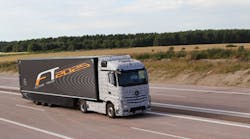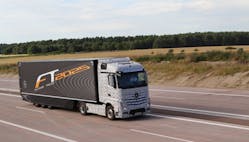Truck drivers remain in scant supply throughout the United States, with the American Truckers Association projecting a shortage of more than 200,000 over the next decade if the situation doesn’t change significantly. There are numerous reasons why so many driver positions are open: the average trucker is in his mid-50s (drivers are predominantly male) and reaching retirement age; the Hours of Service regulations limit productivity and flexibility; while the pay is decent, it doesn’t compensate for time away from home.
According to the Wall Street Journal, some trucking companies are trying to lure drivers by offering attractive healthcare benefits, purchasing newer and more comfortable cabs, and limiting the amount of days drivers have to be on the road. Even so, “it’s probably the most difficult recruiting environment I’ve seen in my 26 years in the business,” Scott McLaughlin, president of Stagecoach Cartage & Distribution, told the WSJ.
But that could all change at some point in the near future, if technology catches up to potential. German vehicle manufacturer Daimler has developed and is testing a self-driving truck with an artificial intelligence-based Highway Pilot system that allows the vehicle to drive autonomously at speeds up to 53 mph (85 km/hr). The Mercedes-Benz Future Truck 2025 offers a glimpse at the possible future of trucking, as a prototype vehicle was recently demonstrated on a closed-off German highway.
The Future Truck 2025 will lead to “more efficiency and better safety and connectivity,” says Wolfgang Bernhard, a member of Daimler’s board of management who is responsible for Daimler trucks and buses. “The focus is the connectivity of the truck with its complete environment. That starts with the driver and the hauler and includes the infrastructure and other traffic participants.”
Daimler compares its technology to an autopilot system in an airplane, and part of the appeal of the project lies in having all trucks in the future interacting with each other through a communications network. This type of autonomous driving would, Daimler says, allow the trucks to operate without direct driver intervention. If you accept Daimler’s premise, by freeing up drivers from the tedious task of keeping their hands on the wheel and their eyes on the road, they’ll be able to take on advanced positions as transport managers, theoretically “making truck driving a more attractive profession.” Whether truck drivers themselves would feel comfortable letting the truck itself do the driving remains to be seen.







